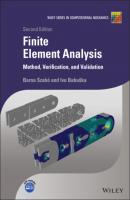Finite Element Analysis. Barna Szabó
Чтение книги онлайн.

Читать онлайн книгу Finite Element Analysis - Barna Szabó страница 32
Название: Finite Element Analysis
Автор: Barna Szabó
Издательство: John Wiley & Sons Limited
Жанр: Физика
isbn: 9781119426462
isbn:
where
Remark 1.8 When plotting quantities of interest such as the functions
Indirect computation of
The first derivative in node points can be determined indirectly from the generalized formulation. For example, to compute the first derivative at node xk from the finite element solution, we select
(1.86)
Test functions used in post‐solution operations for the computation of a functional are called extraction functions. Here
(1.87)
where, by definition;
Example 1.8 Let us find
and by indirect computation:
Example 1.9 The following example illustrates that the indirect method can be used for obtaining the QoI efficiently and accurately even when the discretization was very poorly chosen. We will consider the problem
where δ is the delta function, see Definition A.5 in the appendix. Let us be interested in finding the approximate value of